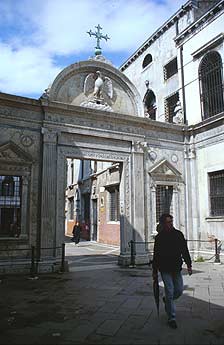 Scuola Grande di San Giovanni Evangelista - San Polo, 2454
- Venice
Scuola Grande di San Giovanni Evangelista - San Polo, 2454
- Venice
The Scuola Grande di San Giovanni Evangelista is located in San Polo in front of the church and in the small square with the same names. It contains works dating back to the Gothic, Renaissance and Baroque periods and is among the oldest in the city.
For the works dedicated to it and for the significance of the treasure it held, undoubtedly this School represented one of the most important Venetian lay institutions. St. John in the Christian tradition is a particular apostle in fact, known as "the disciple loved by Jesus" was the only one to remain with him until his death.
Nowadays it is a museum and concert venue but also hosts conferences, weddings and gala evenings.
Architecture
From a first medieval fabrica, of which remain original the size and shape of the square paved only later, which is accessed through the marble septo, an arched portal by Pietro Lombardo (1478-1481), a masterpiece of Venetian Renaissance sculpture. In a triumph of marbles decorated with floral motifs, two architraved windows with frieze and triangular tympanum above and quadrangular columns on the sides. At the center, a portal with frieze bears the inscription DIVO IOANNI APOSTOLO ET EVANGELISTAE PROTECTORI ET SANCTISSIMAE CRUCI, that is, To Apostle John and to the Protector Evangelist and to the Most Holy Cross.
The composition is admirably enclosed in fluted pilasters, floral frieze and tympanum with a round arch in which is housed a sculpture of an eagle, symbol of the evangelist Giovanni, placed on three volumes. Above it stands a large bronze cross.
Inside the square you can see the church on the left and the school entrance on the right. The fa�ade here is sober with a rectangular portal with a central mask and bas-reliefs at the corners of the architrave representing some friars kneeling in prayer. The same motif is found to the left of the entrance where large bas-relief presents the confreres of the Scuola Grande in prayer in front of St. John and above a Madonna with Child. On the fa�ade, on the main floor, there are five single windows with pointed arch and Corinthian columns quadrangular on the sides, above the windows are reduced to 5 lunettes.
Interior and works
Once inside there's the atrium with wooden beam ceiling, a remnant of the 15th century reconstruction, followed by the Sala delle Colonne (XIV century) where the pilgrims gathered, arriving from all over Europe, but also the confreres before entering the Capitular Hall above. The room takes its name from the 5 columns that divide the space into two sectors and hold a long wooden beam where the overlying beams of the ceiling rest. The columns have capitals with an owl's beak dating back to 1350, representing a confrere and the pastoral of San Giovanni.
Through an architraved portal and a beautiful frieze and fluted pilasters on the sides leads to the Monumental Staircase, designed by Mauro Codussi (1498); the brilliant architect here creates a perspective effect with a staircase that grows in width going upstairs. The two flights of the staircase have a stone handrail with a false balustrade in white marble with square panels, a half-ramped floor with a window and a dome at the top that stands on 4 richly decorated arches that embellish the entrance to the Chapter Hall.
The current appearance is the result of the intervention by Giorgio Massari (1727-62) who is also the author of the monumental altar, in light marbles with gray veins, which houses the statue of St. John the Evangelist who writes the Gospel, flanked by a eagle (symbol of the Saint) and a cherub (symbol of divine inspiration), by the sculptor Giovanni Maria Morlaiter (1732-1733). On the walls there are paintings that narrate episodes of the life of the Saint taken from the Legenda Aurea by Jacopo da Varazze, while on the ceiling there is a pictorial cycle taken from the book of the Apocalypse, text written by St. John. At the corners there are two works by Giandomenico Tiepolo. The hall is 11 meters high, has twelve oval windows, and a diamond-shaped polychrome marble floor with stars in the center of the room.ù
The route continues with the Sala degli Stucchi or Cancelleria (1757), a room with three doors and three single-light windows. Here the decorative apparatus, masterpiece by Antonio Adami and Francesco Re from Ticino, presents white figures on the walls and on the ceiling on yellow and blue backgrounds framed by floral motifs. The rich allegorical decoration - in the center of the ceiling you can see the Faith - is typical of the eighteenth century and of the Venetian Rococo.
The most beloved work of the confreres is preserved in the Oratory of the Cross where on the altar there is a Gothic reliquary made of rock crystal and gilded silver with a reliquary in the top that preserves two fragments of the Cross. The relic came as a gift to the School (1369) by the French knight Philippe de Mezi�res, Grand Chancellor of the Order of Cyprus and Jerusalem. At the center of the ceiling, the Triumph of the Cross by Francesco Maggiotto (1784-1788) is surrounded by elegant floral decorations and golden frames on light blue and pale green backgrounds. In the rounds an eagle, the pastoral - symbols of Saint John - and the chalice with the poison that the saint would have drunk remaining unharmed. On the walls here one could admire the pictorial cycle of the Cross, now kept at the Gallerie dell'Accademia.
The Sala dell'Albergo, with a sixteenth-century layout, was used for meetings of the Government of the Scuola divided into Banca and Zonta. On the walls you can see four paintings depicting episodes taken from the Apocalypse, by Jacopo Palma il Giovane (1581-1582). Under the paintings are placed wooden dossums with the seats where rulers could sit.
In the eighteenth century next to this room a second one was added, always destined to the Government of the School; known as the Hall of the Archive and Council today takes its name from the author of the ceiling frescoes, Jacopo Guarana (1720-1808). In the ceiling we see St. John the Evangelist writing the Gospel where we see the usual eagle, an angel and three cherubs. The symbols of the school are repeated in golden ovals: the reliquary of the Cross, the pastoral, the chalice with the snake, the eagle and the books.
In the four white ovals there are allegories of the virtues necessary for the good governance of the confraternity: Prudence, Justice, Temperance, Fortress.
The last room is the Sala Verde, from the color of the beautiful slate floor, which today is the School's ticket office and bookshop. On the ceiling there is a thick wooden beam from the 16th century and on the painted walls donated by the confreres: Portrait of the Great Guardian Andrea Vendramim, Presentation of Jesus at the Temple, Apparition of the Angel at St. Peter's.
History
Contemporary to the oldest School of Charity (the year of foundation would, in fact, of the following year: 1261), the Scuola di San Giovanni Evangelista received the greatest notoriety when in 1369, the Guardian Grande della Confraternita, Andrea Vendramin, received from one of the leading officials of the kingdom of Cyprus, the Relic of the Cross received from the patriarch of Constantinople. Thanks to this donation, the confraternity assumed a prestige and a reputation previously unknown, so much so that the faithful took the moral commitment to make the building up to the treasure it still contains.
The extraordinary hall at the Gallerie dell'Accademia, which houses them, leaves us esteemed: Procession of the Cross in Piazza S. Marco, The Miracle of the Cross at the Ponte di S. Lorenzo, both by Gentile Bellini and The Miracle of the Relic of the Cross by Vittore Carpaccio, beyond that for the deeply religious meaning that they express, they impress for the extreme clarity with which they give us splits of the Venetian life of that time.
Similarly to the artistic events, the architectural practices proceed: around 1415 the School was probably already finished because the canvases and pictorial cycles were commissioned to decorate the internal rooms. While at the turn of the fifteenth century, the school was equipped with a lateral fa�ade with a clear gothic-floral imprint and was completed only towards the end of the same century on a project by Bartolomeo Bon, the enchanting marble portal. Topped by a lunette, which at the time gave access to the private courtyard, and bordered by the school building on the right side and the old church on the left.
As in many other schools of rank, one of the points where more attention was paid and at the same time emphasis and pomp, was that of the staircase that allowed access to the upper floor, notoriously used as a board room. We are in 1498 when Mauro Codussi, one of the most famous architects working in Venice, draws up the project and realizes it, characterizing it with the classic two-light window on the intermediate floor, an element that has always been present and emblematic of the Codussian architecture.
After the suppression of the beginning of the 19th century, the school seemed to be destined to destruction, when the Austrian government, which took over from the French, thought to transport the marble floor of the main floor entirely to adorn some church or imperial palace. Only love and attachment to the School and the values ??that it represented and had embodied for centuries, prompted some worthy Venetian citizens to raise the funds necessary for the purchase of the building, thus donating it to the art world forever.
How to reach the Scuola Grande di San Giovanni Evangelista
The Scuola Grande di San Giovanni Evangelista is located in San Polo in Campo San Giovanni Evangelista.
You can walk to Piazzale Roma or from the Station while the nearest water-bus stop is Riva de Biasio reachable by the line 1. Then you must walk towards Campo San Nazario Sauro for 300 meters and go diagonally towards the Fondamenta canal of Rio Marin making it all in the left direction. After 20 meters from the end of the foundation is the Scuola Grande di San Giovanni Evangelista.
Hours: from 9.30 to 14.00 and from 14.30 to 17.15 (the ticket office closes at 4.45 pm). Important: the Scuola Grande San Giovanni Evangelista opens only on days when the usual congress activities are not held. Please refer to the official website for the opening calendar on a monthly basis.
Tickets: fullè 10; students under 26 and residentsè 8; school studentsè 3. Free for under 12 children accompanied by adults, handicapped persons, licensed tour guides, ICOM members.
Telephone: +39.041.718234
E-mail: [email protected]
Website: Scuola
Grande di San Giovanni Evangelista |

 Boat Tickets. Coming to Venice? Book in advance and skip the line!
Boat Tickets. Coming to Venice? Book in advance and skip the line! Scuola Grande di San Giovanni Evangelista - San Polo, 2454
- Venice
Scuola Grande di San Giovanni Evangelista - San Polo, 2454
- Venice